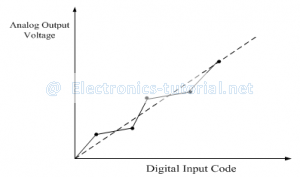Data Converters
Performance parameters/specifications of Data Converters:
1.) Resolution:
It is basically defined in two ways.
It is the number of different analog output values that can be provided by DAC.
For an n-bit DAC,
It is also defined as the ratio of a change in output voltage resulting from a change of 1 LSB at the digital inputs.
For an n-bit DAC,
Where, VOFS is the Full scale output voltage (i.e. output when all input bits are 1)
If VOFS = 10 V and n = 8,
An input change of 1 LSB causes output to change by 39.2156 mV
Output equation of a DAC,
2) Accuracy:
It is the comparison of actual output voltage with an expected output voltage. It is expressed in percentage.
Ideally accuracy= ± 1/2 LSB
Accuracy= VOFS/(2^n-1) [1/2]
If VOFS = 10.2 V and n = 8
∴Accuracy= 10.2/(2^8-1) [1/2]=20 mV
It depends on the accuracy of the resistors used in the ladder and the precision of the reference voltage used.
3)Linearity:
It is the measure of the linearity between binary input and analog output. The linearity of D/A converter is defined as the precision with which the digital input is converted into analog output.
An ideal DAC produces equal increments in analog output for equal increments in digital inputs as shown in dotted line curve of the transfer characteristics below.
However, in practical D/A converter, the gain and offset errors due to resistors introduce non-linearity as shown with solid line of the transfer characteristic.
4) Conversion time/Setting time:
It is the time required for the DAC to convert digital input to a corresponding analog output voltage. It depends on the switch characteristics and amplifier response.
5) Stability/Temperature sensitivity:
This is introduced due to the temperature sensitivity of the reference voltages, the resistors used in the converters, the op-amp and its offset voltages. Therefore, this factor determines the stability of D/A converter.
Settling time:
This is the time required for the output of DAC to settle to within ±1/2 LSB of the final value for a digital input i.e. 0 to VOFS. It should be as small as possible. It depends on the switching time of the logic circuits, which in turn depends on the stray capacitances and inductances present in the converter circuit. The settling time normally ranges from 100 ns to 10 μs based on the word length and the conversion technique used.
Monotonicity:
A D/A converter is said to be monotonic if its output value increases as the binary inputs are incremented from one value to the next. That is, the staircase output can have no downward step as the binary input is incremented. The monotonic characteristics are important in control applications, without which, oscillations will result. If a D/A converters are identified to be monotonic, the error must be less than ±1/2 LSB at each output level. Hence, all the D/A converter ICs are designed to have linearity error of less than ±1/2 LSB always.
Offset Voltage:
When all the bits of binary input sequence are zero, the output of D/A converter should be 0V; but practically a small output voltage is present called as offset voltage or offset error as shown in figure below. The offset error is nullified by translating the practical D/A converter characteristics up or down so that it goes through origin as shown in figure below.

